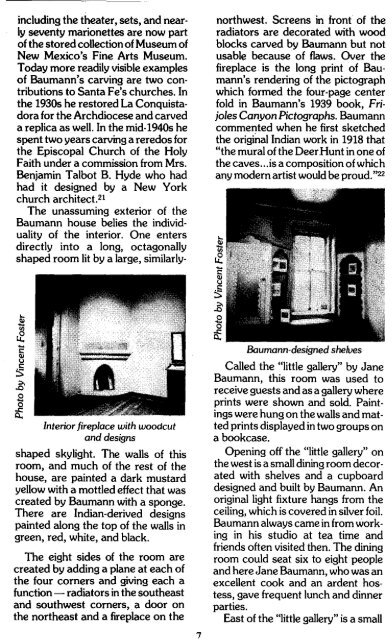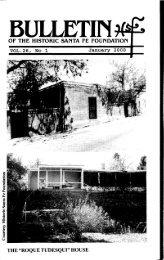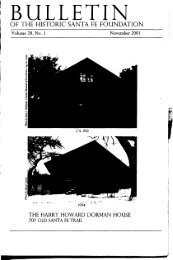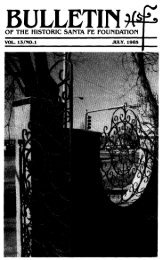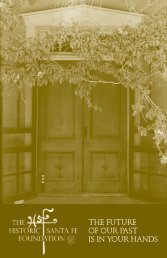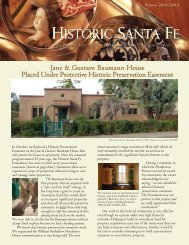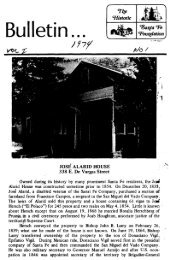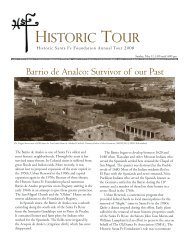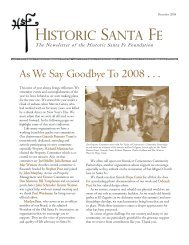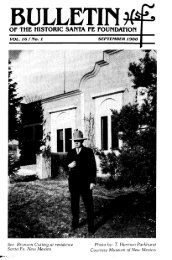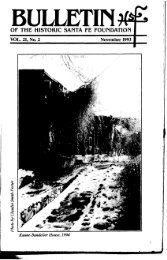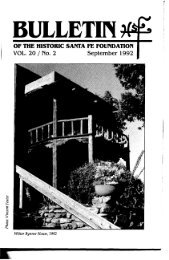BULLETIN - Historic Santa Fe Foundation
BULLETIN - Historic Santa Fe Foundation
BULLETIN - Historic Santa Fe Foundation
Create successful ePaper yourself
Turn your PDF publications into a flip-book with our unique Google optimized e-Paper software.
including the theater, sets, and nearly<br />
seventy marionettes are now part<br />
of the stored collection of Museum of<br />
New Mexico's Fine Arts Museum.<br />
Today more readily visible examples<br />
of Baumann's carving are two contributions<br />
to <strong>Santa</strong> <strong>Fe</strong>'s churches. In<br />
the 1930s he restored La Conquistadora<br />
for the Archdiocese and carved<br />
a replica as well. In the mid-1940s he<br />
spent two years carving a reredos for<br />
the Episcopal Church of the Holy<br />
Faith under a commission from Mrs.<br />
Benjamin Talbot B. Hyde who had<br />
had it designed by a New York<br />
church architect.21<br />
The unassuming exterior of the<br />
Baumann house belies the individuality<br />
of the interior. One enters<br />
directly into a long, octagonally<br />
shaped room lit by a large, similarly-<br />
...<br />
~ '"<br />
~ .•..<br />
s:::<br />
Ql<br />
U<br />
s:::<br />
$<br />
.s<br />
.2o<br />
if<br />
Interior fireplace with woodcut<br />
and designs<br />
shaped skylight. The walls of this<br />
room, and much of the rest of the<br />
house, are painted a dark mustard<br />
yellow with a mottled effect that was<br />
created by Baumann with a sponge.<br />
There are Indian-derived designs<br />
painted along the top of the walls in<br />
green, red, white, and black.<br />
The eight sides of the room are<br />
created by adding a plane at each of<br />
the four corners and giving each a<br />
function - radiators in the southeast<br />
and southwest corners,. a door on<br />
the northeast and a fireplace on the<br />
7<br />
northwest. Screens in front of the<br />
radiators are decorated with wood<br />
blocks carved by Baumann but not<br />
usable because of flaws. Over the<br />
fireplace. is the long print of Baumann's<br />
rendering of the pictograph<br />
which formed the four-page center<br />
fold in Baumann's 1939 book, Frijoles<br />
Canyon Pictographs. Baumann<br />
commented when he first sketched<br />
the original Indian work in 1918 that<br />
"the mural of the DeerHunt in one of<br />
the caves ...is a composition of which<br />
any modern artist would be proud. "22<br />
Baumann-designed shelves<br />
Called the "little gallery" by Jane<br />
Baumann, this room was used to<br />
receive guests and as a gallery where<br />
prints were shown and sold. Paintings<br />
were hung on the walls and matted<br />
prints displayed in two groups on<br />
a bookcase.<br />
Opening off'the "little gallery" on<br />
the west is a small dining room decorated<br />
with shelves and a cupboard<br />
designed and built by Baumann. An<br />
original light fixture hangs from the<br />
ceiling, which is covered in silver foil.<br />
Baumann always came in from working<br />
in his studio at tea time and<br />
friends often visited then. The dining<br />
room could seat six to eight people<br />
and here Jane Baumann, who was an<br />
excellent cook and an ardent hostess,<br />
gave frequent lunch and dinner<br />
parties.<br />
East of the "little gallery" is a small


